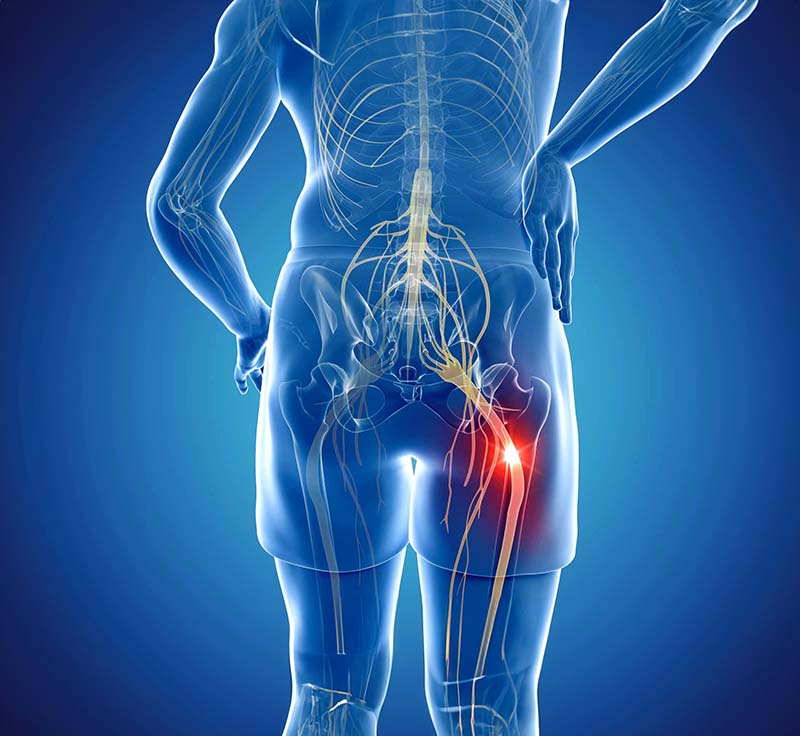Inflammation plays a significant role in why sciatica can be such a troublesome condition. The good news is that certain vitamins can aid in controlling inflammation and other contributing factors of sciatica. This article delves into the dynamic world of various vitamins and minerals that are effective in alleviating sciatica symptoms!
1. What is Sciatica?
Sciatica refers to pain that originates in the back and radiates down the leg, following the path of the sciatic nerve. This nerve emerges from the nerve roots in the lower spine, passes through the hip and buttock area, and extends down the back of the leg to the knee. It also has branches reaching down to the foot.
The primary cause of sciatica is pressure on the sciatic nerve or one of its nerve roots. Most often, the issue stems from the spine, even though the pain is experienced in the leg.
Note: It’s important to recognize that sciatica can be managed with a variety of approaches. Regular exercise and maintaining a healthy weight can help alleviate pressure on the spine. In some instances, applying heat or cold to the affected areas can provide temporary relief. For persistent or severe cases, seeking medical advice is crucial for appropriate treatment, which may include physical therapy or, in some cases, surgical intervention. Remember, early intervention can prevent the progression of symptoms and lead to a quicker recovery.

2. Unraveling the Causes of Sciatica
Sciatica arises due to pressure on or harm to the sciatic nerve, which begins in the lower back and extends down each leg. This crucial nerve is responsible for controlling the muscles in the back of the knee and lower leg and also provides sensation to various parts of the leg and foot, including the back of the thigh, outer and back parts of the lower leg, and the sole of the foot.
The usual culprits behind sciatica include:
- Slipped or herniated disk
- Spinal stenosis (narrowing of the spine)
- Piriformis syndrome, which is a pain disorder involving a narrow muscle in the buttocks
- Pelvic injuries or fractures
- Tumors
- Spondylolisthesis (a condition where a vertebra slips forward over the bone below it)
Notably, men in the 30 to 50 age bracket are at a higher risk of developing sciatica.
Note: It’s essential to approach sciatica with a well-rounded treatment plan. Physical therapy and exercises targeting the lower back can provide significant relief. Maintaining proper posture and using ergonomic furniture can also prevent aggravation of sciatica. In some cases, medical treatments or surgery might be necessary, especially when conservative methods don’t yield results. Always seek professional medical advice for an accurate diagnosis and treatment plan tailored to your specific condition.

3. Symptoms and Manifestations of Sciatica
Sciatica pain manifests in a range of sensations. It can be a gentle tingling, a persistent dull ache, or even a burning feeling. In extreme cases, the pain may be so intense that it impedes movement.
Typically, sciatica affects only one side of the body. It’s common for individuals to experience sharp pain in one area of the leg or hip, coupled with numbness in other parts. This pain or numbness might extend to the back of the calf or the sole of the foot. The leg impacted by sciatica might also feel weak, and there could be difficulty lifting the foot off the ground while walking.
The onset of sciatica pain can be gradual. It often worsens:
- After prolonged standing or sitting
- At specific times, like at night
- During activities that increase spinal pressure like sneezing, coughing, or laughing, particularly if it’s related to a herniated disk
- When bending backwards or walking more than a short distance, especially if spinal stenosis is the cause
- While straining or holding breath, such as during bowel movements
Note: If you’re experiencing sciatica symptoms, it’s crucial to avoid activities that worsen the pain. Gentle stretching exercises and yoga can be beneficial in some cases. However, it’s advisable to consult a healthcare professional for personalized advice and treatment options, especially if the pain persists or worsens. Remember, early and appropriate intervention can significantly enhance the effectiveness of treatment strategies.

4. The Role of Vitamins in Treating Sciatica
Many people with sciatica, a condition causing sharp pain from the lower back down the legs, are turning to natural remedies. This includes using vitamins to ease pain and improve nerve health. Sciatica can come from different causes, such as a slipped disc or pinched nerves in the spine.
In this part, we’re looking at how vitamins can help with sciatica pain. We’ll talk about specific vitamins that studies suggest might help reduce swelling, help nerves heal, and make the pain less severe.
Knowing which vitamins might help with sciatica allows people to think about adding these to their daily routine. We’re going to explore how vitamins can be a helpful, natural way to deal with the pain of sciatica.
Note: It’s always good to talk to a doctor before starting any vitamins, especially if you’re already taking other medicines or have health problems. Eating well, staying active, and keeping a good posture are also important for keeping your nerves healthy and avoiding sciatica.

5. Types of Vitamins for Sciatica that Help Reduce Pain
Vitamins are key in keeping nerves healthy, lowering inflammation, and boosting overall health. Here, we explore the top vitamins and nutrients for sciatica and how to use them.

5.1 The Power of Vitamin B12 for Sciatica
Vitamin B12, known as the “nerve health superstar,” offers many benefits for our health. It’s vital for nerve health and easing nerve pain. B12 helps make myelin, a protective layer around nerves that ensures they work well. This prevents problems like neuropathy and nerve damage.
Vitamin B12 can also relieve nerve pain symptoms like tingling, numbness, and burning. Adding B12 supplements to your daily routine can be very helpful, especially for nerve health or pain.
In summary, vitamin B12 is crucial for optimal nerve health. It helps prevent deficiencies and reduces nerve pain, supporting overall well-being. Using B12 supplements or eating B12-rich foods can keep your nerves in good shape.

5.2 Vitamin D: A Key Vitamin for Sciatica
Vitamin D is important for bone and muscle health, which is essential for those with sciatic pain. It can help alleviate back pain and improve how muscles and bones work.
Sciatica can be caused by weak bones and muscles. Vitamin D deficiency can make this worse. Getting enough vitamin D can strengthen your bones and muscles, lowering the risk of sciatica.
Bone health supplements often include vitamin D to help the body absorb calcium, which is important for strong bones. Taking these supplements can raise your vitamin D levels and support healthy bones.
Research shows that vitamin D supplements can help with chronic back pain, like sciatica. They can reduce inflammation and improve nerve function, easing sciatica pain.
To conclude, vitamin D is great for bone and muscle health and relieving sciatica pain. Fixing vitamin D deficiencies through supplements or sunlight can improve overall health and lessen the impact of back conditions like sciatica.

5.3 How Vitamin E Helps in Sciatica
Vitamin E, a fat-soluble vitamin, has antioxidant and anti-inflammatory qualities. It protects nerve cells from damage and inflammation, which can cause pain, especially in late-stage sciatica. Vitamin E also improves blood flow and oxygen to tissues, aiding healing and recovery. You can find vitamin E in nuts, seeds, vegetable oils, and leafy greens. A daily supplement of 200 to 400 IU is also beneficial.

5.4 The Benefits of Vitamin B6 for Sciatica
Vitamin B6 is essential for nerve health and making neurotransmitters. It helps reduce inflammation and can ease sciatica pain. Foods rich in B6 include poultry, fish, beans, nuts, and whole grains. However, talk to your doctor before taking B6 supplements, as too much can be harmful.

5.5 Magnesium: An Essential Mineral for Sciatica
Magnesium, known as the “miracle mineral,” is vital for relaxing muscles and soothing nerves, making it useful for sciatica.
Magnesium helps muscles relax. Without enough magnesium, muscles can tense up, causing pain. Magnesium supplements can reduce muscle spasms and nerve pain in sciatica.
If you have muscle cramps, twitching, or discomfort, you might need more magnesium. Adding magnesium to your diet or taking supplements can improve your well-being.
Magnesium supplements are popular for sciatica relief. They’re easy to take and can help your muscles work properly, easing nerve irritation from sciatica.
In summary, using magnesium can be a game-changer for sciatica. It relaxes muscles and soothes nerves, offering relief from this painful condition. Magnesium can be found in supplements or certain foods.

5.6 Selenium: A Trace Element for Sciatica Relief
Some studies suggest selenium is good for nerve health and can lower inflammation, which may help with sciatica. Selenium might also reduce damage to the sciatic nerve.

5.7 Omega-3: A Vital Nutrient for Sciatic
Research indicates that high levels of omega-3 fatty acids can protect nerve cells and help them recover after injury.
Oily fish like salmon, mackerel, anchovies, sardines, and herring are great sources of omega-3. These should be balanced with omega-6 fats (found in processed foods and vegetable oils) in a 2:1 ratio. Most Western diets have too much omega-6, which can cause inflammation. Eating more omega-3 and less omega-6 can help with inflammation.
Signs of omega-3 deficiency include swollen hands and wrists, dry skin, eczema, skin redness, or cracked fingertips.
If you don’t eat enough oily fish, consider taking a high-quality fish oil or cod liver oil supplement.

6. Precautions When Using Vitamins to Support Sciatica Treatment
When incorporating vitamins into your sciatica treatment plan, it’s essential to exercise caution and seek advice from a healthcare professional. Here are some key precautions to keep in mind:
- Avoid Overdoing It: Excessive consumption of certain vitamins, like vitamin B6, can lead to nerve damage and exacerbate sciatica symptoms. It’s crucial to stick to recommended dosages.
- Consult a Healthcare Provider: Before starting any supplement or making significant changes to your diet, it’s important to talk to a healthcare provider. They can advise on what’s safe and effective for your particular situation.
- Eat a Balanced Diet: While supplements can help, nothing beats a well-rounded diet. Ensure you’re eating a variety of nutrient-packed foods, such as leafy greens, eggs, nuts, and fatty fish.
- Stay Away from Processed Foods: These foods often contain high levels of sugar, salt, and unhealthy fats, which can lead to increased inflammation and worsen sciatica symptoms.
- Keep Hydrated: Drinking plenty of water is vital. It can help reduce inflammation and support overall health.
Alongside taking vitamins and supplements, other lifestyle adjustments can aid in managing sciatica symptoms. These include regular exercise, stretching, and physical therapy. It’s important to collaborate with a healthcare provider to create a tailored treatment plan that meets your unique needs and health goals.
Note: Remember, while vitamins and lifestyle changes can provide relief, they’re part of a broader approach to managing sciatica. It’s always best to seek a professional’s guidance to ensure you’re on the right track.
7. Conclusion
In conclusion, exploring the role of vitamins for sciatica can be a game-changer in managing this challenging condition. From the nerve-nurturing properties of Vitamin B12 to the muscle-supporting benefits of Vitamin D, and the inflammation-reducing power of Omega-3s, these nutrients offer valuable support in the battle against sciatica pain. However, it’s crucial to remember that a balanced diet, regular exercise, and professional medical advice are equally important in creating an effective treatment plan for sciatica.
We’d love to hear your stories and feedback on how vitamins have impacted your journey with sciatica. Your experiences can provide invaluable insights to others facing similar challenges. Feel free to share your thoughts and join the conversation.
For more informative content like this, don’t forget to check out our other blogs at Biosculpture. We continuously strive to provide helpful and insightful information to support your health and wellbeing journey.


